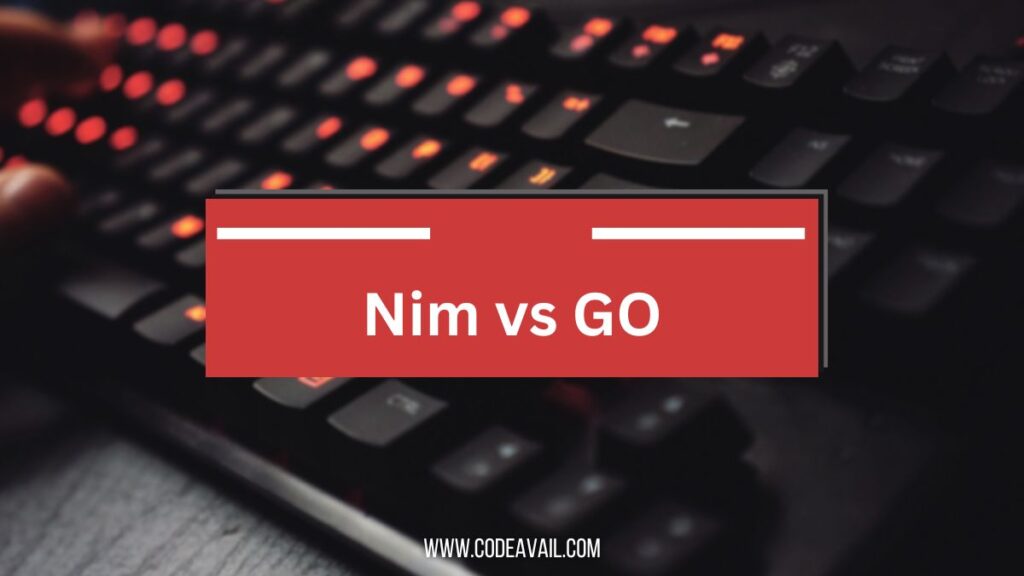Welcome to our special blog, where we’ll compare Nim vs Go, two awesome programming languages! These languages are like superpowers for software development, making everything from simple websites to cool mobile apps possible.
In the world of coding, there are so many languages to choose from, but Nim and Go have become super famous among developers all over the world. In this blog, we’ll dive deep into these languages, checking out what makes them unique and powerful. Don’t worry if you’re new to coding – we’ll keep it super simple and easy to understand!
We’ll explore all the cool stuff about Nim and Go, like how fast they work, how easy they are to use, and what kind of projects they’re best for. By the end, you’ll know which one suits your needs best. So, prepare for an exciting journey as we uncover the magic of Nim and Go together!
Nim: A Versatile and Efficient Language
Table of Contents
Nim is a statically typed, compiled language known for its expressive and readable syntax. It aims to combine the best aspects of other popular languages like Python, Pascal, and Ada, making it an attractive choice for various applications. Nim’s primary focus is on performance and portability, enabling developers to write code that runs efficiently on multiple platforms.
Features of Nim Programming Language
- Expressive and readable syntax, resembling Python, Pascal, and Ada.
- Statically typed with strong type inference, ensuring code safety and efficiency.
- Excellent performance and memory management, allowing fine-tuning for optimized code.
- Cross-platform compatibility, enabling code to run on multiple operating systems seamlessly.
- Asynchronous and concurrent programming with async procedures, although not as native as Go.
| Also read: zig vs nim |
Go: The Language for Scalable Systems
Go, also known as Golang, is an open-source, statically typed language developed by Google. It is designed with concurrency and scalability in mind, making it an excellent choice for building large-scale distributed systems. Go’s simple and straightforward syntax makes it easy to learn and work with, even for beginners.
Features of Go Programming Language
- Minimalistic and simple syntax, enhancing code readability and reducing complexity.
- Static typing with explicit declarations, ensuring safe and predictable code behavior.
- Robust support for concurrent programming with goroutines, simplifying scalable systems.
- Efficient compilation and fast development cycles due to a quick and reliable compiler.
- Strong community backing from Google, fostering regular updates and a vast ecosystem of libraries.
Comparison: Nim vs Go
Syntax and Readability
When comparing the syntax of Nim and Go, Nim tends to resemble Python and other high-level languages, making it more approachable for developers coming from these backgrounds. Go, on the other hand, has a minimalistic syntax, which can appear more cryptic to those used to verbose languages. However, this simplicity contributes to Go’s readability and reduces the likelihood of bugs caused by complex code structures.
Concurrent Programming
One of the standout features of Go is its robust support for concurrent programming. Go utilizes goroutines, lightweight threads that enable developers to perform concurrent tasks without excessive overhead. This makes it easier to create scalable systems that can efficiently handle multiple operations simultaneously. In contrast, Nim does have concurrency support through async procedures, but it is not as native and polished as Go’s goroutines.
Performance and Compilation
Nim boasts impressive performance due to its static typing and efficient code generation. The language allows developers to fine-tune memory allocation and optimize performance-critical sections of their code. Nim’s compilation process is also relatively fast, resulting in quicker development cycles.
On the other hand, Go’s performance is slightly behind Nim, but it compensates with its straightforward compilation process and excellent garbage collection mechanism. Go’s compiler is famously fast, making it a favorite among developers who prioritize rapid development and deployment.
Community and Ecosystem
When evaluating a programming language, it’s essential to consider the community and available ecosystem. Go has a robust and active community backed by Google, ensuring regular updates, bug fixes, and continuous improvements. The Go ecosystem offers a plethora of libraries and frameworks that streamline development, contributing to its growing popularity for web development and system-level programming.
Nim’s community is smaller compared to Go’s, but it’s enthusiastic and dedicated. Nim’s ecosystem has been steadily growing, and it boasts several useful libraries for various domains, including web development, game development, and more. However, Nim may not have as many mature libraries as Go due to its relatively recent rise in popularity.
Nim vs Go: Ideal Use Cases
Choosing the right language depends on the project’s specific requirements. Here are some scenarios where Nim or Go could excel:
Nim:
- Projects requiring high performance and low-level control.
- Cross-platform applications targeting multiple operating systems.
- Systems programming, such as operating systems, device drivers, etc.
Go:
- Large-scale distributed systems and network applications.
- Web development, especially for server-side applications and APIs.
- Projects that require robust concurrency and parallel processing.
Conclusion
In conclusion, both Nim and Go are exceptional programming languages with unique strengths and weaknesses. Nim’s emphasis on performance and versatility, combined with its approachable syntax, make it a fantastic choice for performance-critical and cross-platform applications. Go’s simplicity, concurrency support, and scalability make it a top choice for building distributed systems and web applications.
Aspiring developers should consider their project’s requirements and desired outcomes before deciding between Nim and Go. Regardless of the choice, both languages offer exciting opportunities for anyone keen on learning and mastering a modern programming language.

